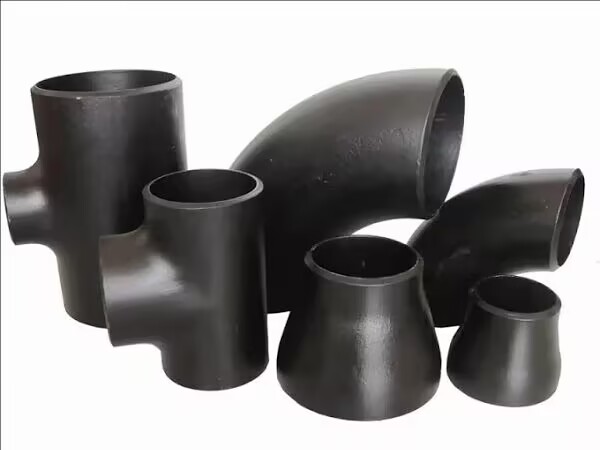Carbon steel pipe fittings (CSFT) are pipe connection components made mainly of carbon steel through processes such as smelting, forming, processing, welding and surface treatment. In piping systems, carbon steel pipe fittings are often used for connecting, branching, changing direction or sealing pipelines. Common connection methods include welded pipe fittings, threaded pipe fittings, socket pipe fittings, ferrule pipe fittings, etc. According to their uses, they can be classified into
elbows, tees, crosses, reducers, flanges, heads, etc. It can be classified into categories such as extrusion, pressing, forging and casting according to the processing method.
Carbon steel itself refers to iron-based alloys with a carbon content ranging from 0.02% to 2.04%. According to the carbon content, it can be classified into low-carbon steel (C≤ 0.25%), medium-carbon steel (0.25% < C≤ 0.6%), and high-carbon steel (C > 0.6%). It has low cost, stable mechanical properties and good weldability, making it one of the most widely used materials in the pipe fitting industry.

Manufacturing process of carbon steel pipe fittings
Generally, pipe fittings need to be processed step by step from raw materials. However, there are also some pipe fittings, such as elbows, which can be made by bending straight steel pipes through hot bending or cold bending processes. Other pipe fittings are generally manufactured in accordance with the following processes:
1. Raw material selection and smelting
Carbon steel raw materials that meet the chemical composition requirements are selected. After being melted in an electric furnace or converter, impurities are removed and the composition is regulated to ensure the plasticity and welding performance of subsequent forming.
2. Casting and forging
Cast carbon steel pipe fittings: Molten steel is poured into sand molds or metal molds. After solidification, it undergoes sand cleaning, heat treatment and machining to form the required shape. It is suitable for the production of complex cross-sections or large-sized pipe fittings. Cast carbon steel can be classified into three types: low-carbon, medium-carbon and high-carbon. As the carbon content increases, its strength and hardness also improve.
Forged pipe fittings: The ingot material is heated above the recrystallization temperature, and then extruded, billet formed and forged through a forging hammer or hydraulic press to make the structure more compact. The mechanical properties are superior to those of castings and are often used in the manufacturing of high-pressure grade pipe fittings.
3. Forming process
There are generally two forming processes for pipe fittings: seamless process and welding process. Seamless process is achieved by heating and piercing the tube blank through hot rolling or cold drawing technology, and then passing through multiple hot rolling or cold drawing processes to form a blank without welds. The welding process involves welding steel plates or steel strips that have been rolled into tubular shapes along their edges through resistance welding and other welding techniques. It is very suitable for making large-diameter pipe fittings.
4. Mechanical processing and connection
The pipe fitting blanks are processed by CNC lathes, milling machines and other equipment for end face processing, inner and outer diameter processing, thread cutting or socket surface processing to ensure the connection and fit accuracy.
For components such as flanges and tees that need to be assembled, the final assembly is completed through methods such as butt welding (BW), socket welding (SW), or threaded connection (TR).
5. Surface treatment and inspection
Common surface treatment methods include sandblasting, shot blasting, galvanizing, painting, and anti-corrosion coating, etc., to enhance corrosion resistance and appearance quality. Secondary forming processes such as CNC machining, powder coating, surface hardening or electroplating can also be selected according to the usage requirements.
After completion, hydrostatic testing, radiographic inspection, ultrasonic testing and appearance dimension inspection shall be carried out to ensure no leakage, no cracks and compliance with technical specifications.
Carbon steel pipe fittings can withstand harsh environmental conditions such as high temperatures and steam, making them a suitable choice over other materials. In some applications, piping systems need to transport gases at extremely low temperatures, and brittleness and cracks may pose challenges. In these applications, carbon steel pipe fittings are needed to meet the strict requirements. These pipe fittings are cost-effective and widely popular due to their extensive applications in numerous industries such as sewage treatment, municipal services, and the transportation of water, oil and natural gas.
